Intel has been doing the NUC project for over 3 years now and its a direction that they’ve been doing in the desktop space just like how the laptop evolved from the netbook to the ultrabook and hybrids. The only difference is that there’s not much general need for the desktop PC to really shrink. Unless one has very specific case use. There is where the Intel NUC comes in.
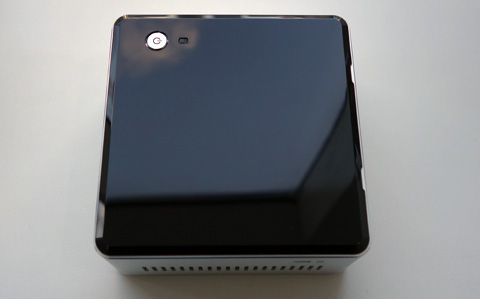
Intel’s idea of the NUC (Next Unit of Computing) is pretty simple but not might make sense will a lot of people at first. The NUC has specific purpose that is inherently brought by its miniaturized form factor.
Intel is not alone in this ambition. A number of PC vendors havebeen doing something similar — The Gigabyte Brix, ECS Liva X, Asus VivoPC and Acer Revo all aimed to take that niche space of mini PCs.
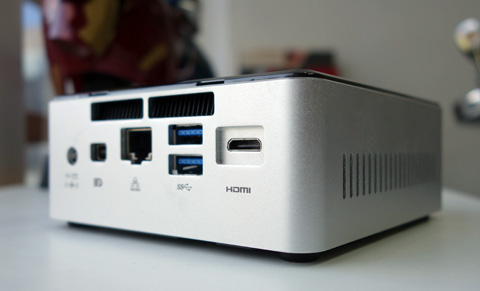
The NUC comes with a very simple and straightforward design which make sense if you want to achieve the most compact build for a fully-functioning PC. The shape allows for an optimized and well-placed components of the PC.
While we will not see the NUC as a common setup in the household, there will be several cases uses for it that makes more practical sense.
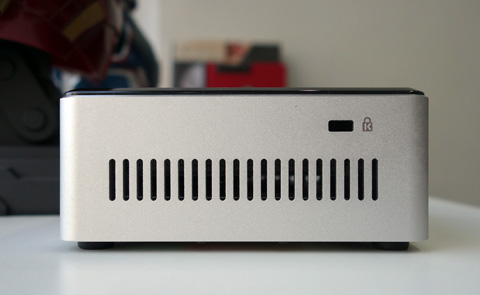
Central to the NUC’s promise is the size and weight. Fit a fully-functioning desktop PC into a 4-inch by 4-inch chassis and you have a portable yet powerful device to carry along anywhere you go.
The aluminum body makes the chassis very solid yet light (weighs about 520 grams depending on the additional parts you add later on) with the top side covered with a black, glossy polycarbonate top. Intel says the top can be taken off and the chassis can be stacked in the future if you want to add more parts.

The bottom side has screws and a mounting plate to attached it to the back of a monitor (the box comes with an extra VESA mount), LED panel or TV.
One side of the NUC is peppered with all standard ports — mini-HDMI, two USB 3.0 ports, a GigaBit LAN port, and mini Display Port.
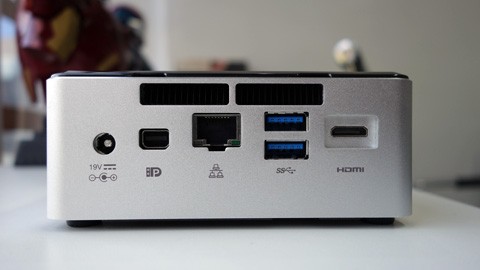
The presence of a Display Port and HDMI port means you can use two minotors simultaneously (although the maximum capacity is actually three monitors). We initially had a hard time setting it up with a monitor because the the mini-HDMI port (we wished they included an adaptor for the standard sizes).
At the front are two more USB ports and a 2-in-1 microphone/earphone jack. The power button is up top.
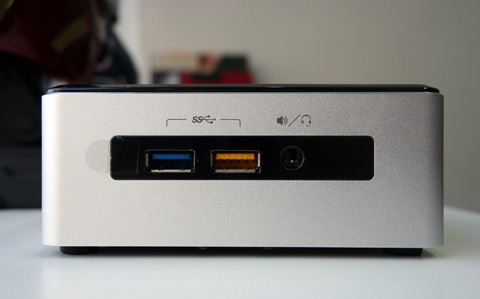
Since the Intel NUC is an open platform, PC Express took the kits and configured three different set-up at specific price categories. The one we have here now is the Cobalt Mainstream which runs on an Intel Core i3 5010U processor with 4GB of RAM. You can have the option to change the 500GB HDD to any type of SSD or upgrade the RAM to 16GB (2x8GB SODIMM sticks) but that will cost you extra.
Cobalt Entry
Intel Celeron N2820 2.39GHz dual-core
Intel HD Graphics
4GB DDR3 RAM
500GB Mobile HDD
15.6? LED monitor
USB Keyboard and mouse
Windows 8.1 OEM
Cobalt Mainstream
Intel Core i3 5010U 2.1GHz dual-core
Intel HD Graphics 5500
4GB DDR3 RAM
500GB Mobile HDD
Intel WiFi 802.11ac
mini HDMI 1.4a with audio support Mini DisplayPort 1.2 with audio support
Intel WiDi Supported
4 X USB 3.0 ports
Headphone/Microphone Jack
18.5-inch LED monitor
USB Keyboard and mouse
Windows 8.1 OEM
Cobalt Pro
Intel Core i5 4250U 1.3GHz dual-core
Turbo Boost 2.6GHz
Intel HD Graphics 5000
4GB DDR3 RAM
1TB Mobile HDD
Intel WiFi 802.11ac
21.5-inch LED monitor
USB Keyboard and mouse
Windows 8.1 OEM
The Intel Cobalt Mainstream already comes with Windows 8.1 pre-installed (coming from the barebones kit) along with an 18.5-inch Samsung LED monitor and a USB keyboard and mouse from Rapoo.
The low-power Broadwell-U processor only 15W (TDP) with the 2 cores (4 threads) going up to 2.1GHz. Average PassMark CPU score is 2963. The Core i3 5010U and 4GB RAM combo works smoothly and efficiently. It’s nowhere near a gaming setup but it can do DoTA2 and Starcraft 2 just fine.

What the NUC offers is a combination of a very tight form factor, low power consumption and a bit of flexibility. Granted, you cannot add your choice of a discrete graphics card but the Intel HD 5500 should suffice (should be in the same level of performance, or slightly lower than a dedicated GeForce 820M GPU). Still, you are able to pick the storage type and capacity and also crank up the RAM to the maximum.
The promise of the NUC is for special case use that’s not normally an issue with regular users — small office desk set-up (concierge, reception), POS machines, large public LED display, computer kiosks, demo machines.
The Cobalt Mainsteam retails for Php28,995 at 12 months, 0% (less Php3,000 for cash) from PC Express and comes with an 18.5-inch Samsung LED monitor and Rapoo keyboard and mouse.
The post Intel PCX Cobalt NUC Quick Review appeared first on YugaTech | Philippines, Tech News & Reviews.





